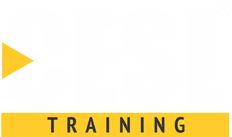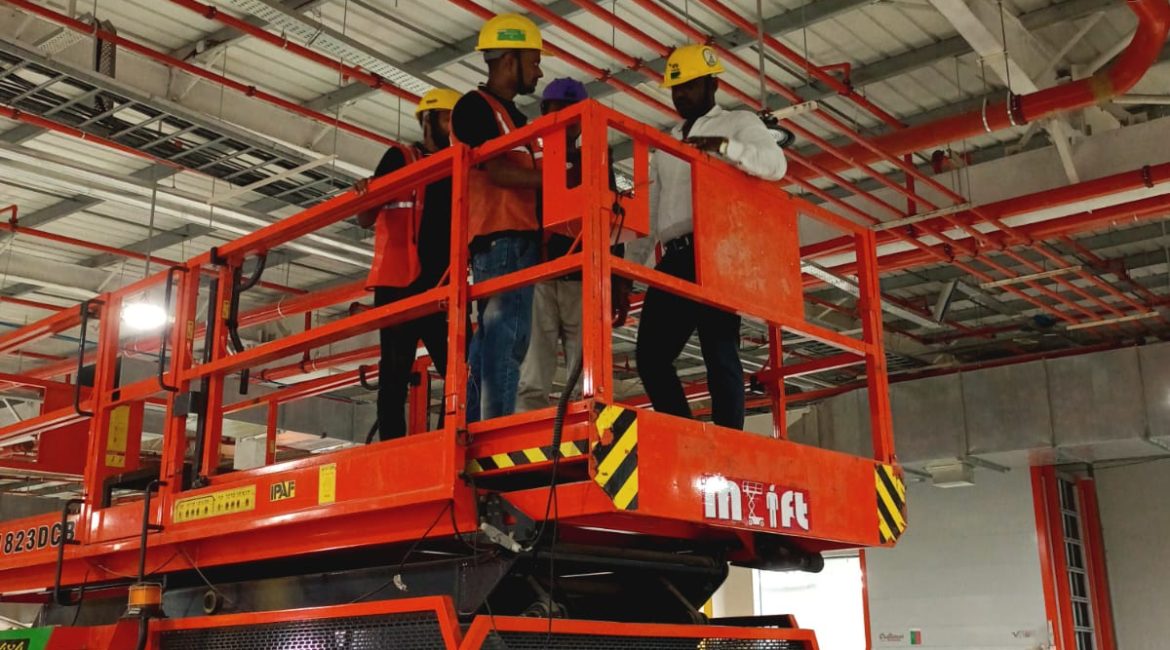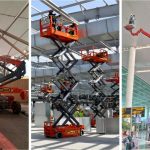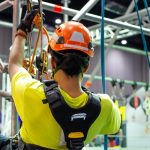Introduction
In the aviation industry, where safety and precision are paramount, the use of Mobile Elevating Work Platforms (MEWPs) in aircraft inspections has become increasingly vital. MEWPs provide the necessary access to hard-to-reach areas of an aircraft, enabling thorough inspections that are crucial for maintaining safety standards. This blog explores the role of MEWPs in aircraft inspections, highlighting how they enhance both precision and safety, and why investing in proper training and equipment is essential for any aviation maintenance operation.

The Importance of Aircraft Inspections
Aircraft inspections are a critical component of aviation maintenance. They ensure that every part of the aircraft, from the fuselage to the engines, is in optimal condition and meets regulatory safety standards. Regular inspections help prevent mechanical failures, enhance the aircraft’s performance, and extend its service life. Given the complexity and size of modern aircraft, accessing all necessary areas for inspection can be challenging. This is where MEWPs come into play.
How MEWPs Enhance Aircraft Inspections
- Access to Hard-to-Reach Areas
Aircraft have numerous components located at various heights and angles, making it difficult to inspect them thoroughly using conventional means. MEWPs provide the flexibility to:- Reach Elevated Components: Inspect critical parts of the aircraft, such as the wings, tail, and top of the fuselage, without compromising safety.
- Maneuver Around the Aircraft: Access different parts of the aircraft quickly and efficiently, reducing the time needed for inspections.
- Adjust Heights and Angles: Position inspectors precisely where they need to be, ensuring no area is overlooked.
- By providing easy access to all areas of the aircraft, MEWPs help ensure that inspections are comprehensive and thorough.
- Improved Safety for Inspectors
Safety is a primary concern in any maintenance operation, and this is especially true during aircraft inspections. MEWPs offer several safety advantages:- Stable Work Platforms: Provide a secure and stable platform for inspectors, reducing the risk of falls or accidents compared to using ladders or scaffolding.
- Advanced Safety Features: Modern MEWPs are equipped with safety features such as guardrails, harness points, and emergency lowering systems, enhancing the safety of the inspection process.
- Controlled Environment: MEWPs allow for controlled and precise movements, reducing the risk of accidental damage to the aircraft or injury to the inspectors.
- By using MEWPs, aviation maintenance teams can perform inspections more safely, protecting both personnel and equipment.
- Enhanced Precision in Inspections
The precision of an aircraft inspection is crucial for identifying potential issues before they become serious problems. MEWPs contribute to precision in several ways:- Closer Inspection of Components: Inspectors can get closer to specific parts of the aircraft, allowing for a more detailed examination.
- Better Visibility: MEWPs provide inspectors with the optimal vantage point to see and assess components accurately, whether they are looking for corrosion, cracks, or other signs of wear and tear.
- Use of Inspection Tools: The stable platform provided by a MEWP allows inspectors to use various tools and equipment, such as cameras or ultrasonic testers, with greater precision.
- The ability to conduct more precise inspections helps in detecting issues early, ensuring that the aircraft remains safe and airworthy.
The Need for Proper MEWPs Training
While MEWPs offer significant advantages for aircraft inspections, their effectiveness depends on the skill and knowledge of the operators. Proper training is essential to:
- Ensure Safe Operation: Operators must understand how to use the MEWP safely, including how to navigate around the aircraft without causing damage.
- Maximize Efficiency: Trained operators can position the MEWP quickly and accurately, minimizing downtime and improving the efficiency of the inspection process.
- Maintain Compliance: Proper training ensures that the use of MEWPs in inspections complies with industry regulations and safety standards.
Investing in comprehensive MEWP training not only enhances safety but also ensures that inspections are carried out efficiently and effectively.
Conclusion
The use of Mobile Elevating Work Platforms (MEWPs) in aircraft inspections is a game-changer for the aviation industry. By providing access to hard-to-reach areas, improving safety, and enhancing precision, MEWPs play a crucial role in maintaining the high standards of safety and performance required in aviation. However, to fully realize these benefits, it is essential to invest in proper MEWP training and equipment. At CESL, we offer specialized training programs tailored to the needs of the aviation industry, ensuring that your maintenance team is equipped with the skills and knowledge they need to perform inspections safely and efficiently.
By leveraging the capabilities of MEWPs, aviation professionals can ensure that their aircraft inspections are more thorough, precise, and safe, ultimately contributing to the overall safety and success of their operations.




